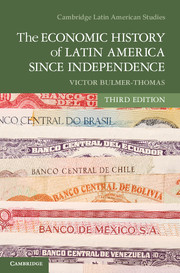Book contents
- Frontmatter
- Dedication
- Contents
- List of Tables, Figures, and Maps
- Preface to the Third Edition
- Preface to the First Edition
- List of Abbreviations
- 1 Latin American Economic Development
- 2 The Struggle for National Identity
- 3 The Export Sector and the World Economy, circa 1850–1914
- 4 Export-Led Growth
- 5 Export-Led Growth and the Nonexport Economy
- 6 The First World War and Its Aftermath
- 7 Policy, Performance, and Structural Change in the 1930s
- 8 War and the New International Economic Order
- 9 Inward-Looking Development in the Postwar Period
- 10 New Trade Strategies and Debt-Led Growth
- 11 Debt, Adjustment, and the Shift to a New Paradigm
- 12 Conclusions
- Appendix 1 Data Sources for Population and Exports before 1914
- Appendix 2 The Ratio of Exports to Gross Domestic Product, the Purchasing Power of Exports, the Net Barter Terms of Trade, and the Volume of Exports, circa 1850 to circa 1912
- Appendix 3 Population, Exports, Public Revenue, and GDP for the Main Latin American Countries before 1914
- Appendix 4 GDP Per Head in Latin America since 1900
- Bibliography
- Index
10 - New Trade Strategies and Debt-Led Growth
Published online by Cambridge University Press: 05 June 2014
- Frontmatter
- Dedication
- Contents
- List of Tables, Figures, and Maps
- Preface to the Third Edition
- Preface to the First Edition
- List of Abbreviations
- 1 Latin American Economic Development
- 2 The Struggle for National Identity
- 3 The Export Sector and the World Economy, circa 1850–1914
- 4 Export-Led Growth
- 5 Export-Led Growth and the Nonexport Economy
- 6 The First World War and Its Aftermath
- 7 Policy, Performance, and Structural Change in the 1930s
- 8 War and the New International Economic Order
- 9 Inward-Looking Development in the Postwar Period
- 10 New Trade Strategies and Debt-Led Growth
- 11 Debt, Adjustment, and the Shift to a New Paradigm
- 12 Conclusions
- Appendix 1 Data Sources for Population and Exports before 1914
- Appendix 2 The Ratio of Exports to Gross Domestic Product, the Purchasing Power of Exports, the Net Barter Terms of Trade, and the Volume of Exports, circa 1850 to circa 1912
- Appendix 3 Population, Exports, Public Revenue, and GDP for the Main Latin American Countries before 1914
- Appendix 4 GDP Per Head in Latin America since 1900
- Bibliography
- Index
Summary
At the beginning of the 1960s it was widely believed that regional integration would restore the dynamism of the inward-looking model of development in the larger republics and provide a platform for industrialization in the smaller countries. Yet by the end of the decade the mood had changed. Regional integration – at least in South America – had not brought the expected gains, and the inward-looking model seemed to be subject to diminishing returns. The prestige of CEPAL, which had nailed its colors to both inward-looking development and regional integration, declined despite the regional organization's best efforts to revise its approach to industrialization, and the Latin American policymaking elite began to pay more attention to alternative ideas on trade and development.
The Achilles’ heel of inward-looking development remained the balance-of-payments constraint. After 1929, persistent balance-of-payments problems had persuaded more and more countries to abandon export-led growth based on primary products in favor of a new model that was expected to lower their vulnerability to external shocks. Yet balance-of-payments problems continued under inward-looking development as the policies adopted to favor industry undermined the export sector and shifted the composition of imports in the direction of complementary goods – the demand for which expanded rapidly in line with industrial growth.
- Type
- Chapter
- Information
- The Economic History of Latin America since Independence , pp. 346 - 390Publisher: Cambridge University PressPrint publication year: 2014

